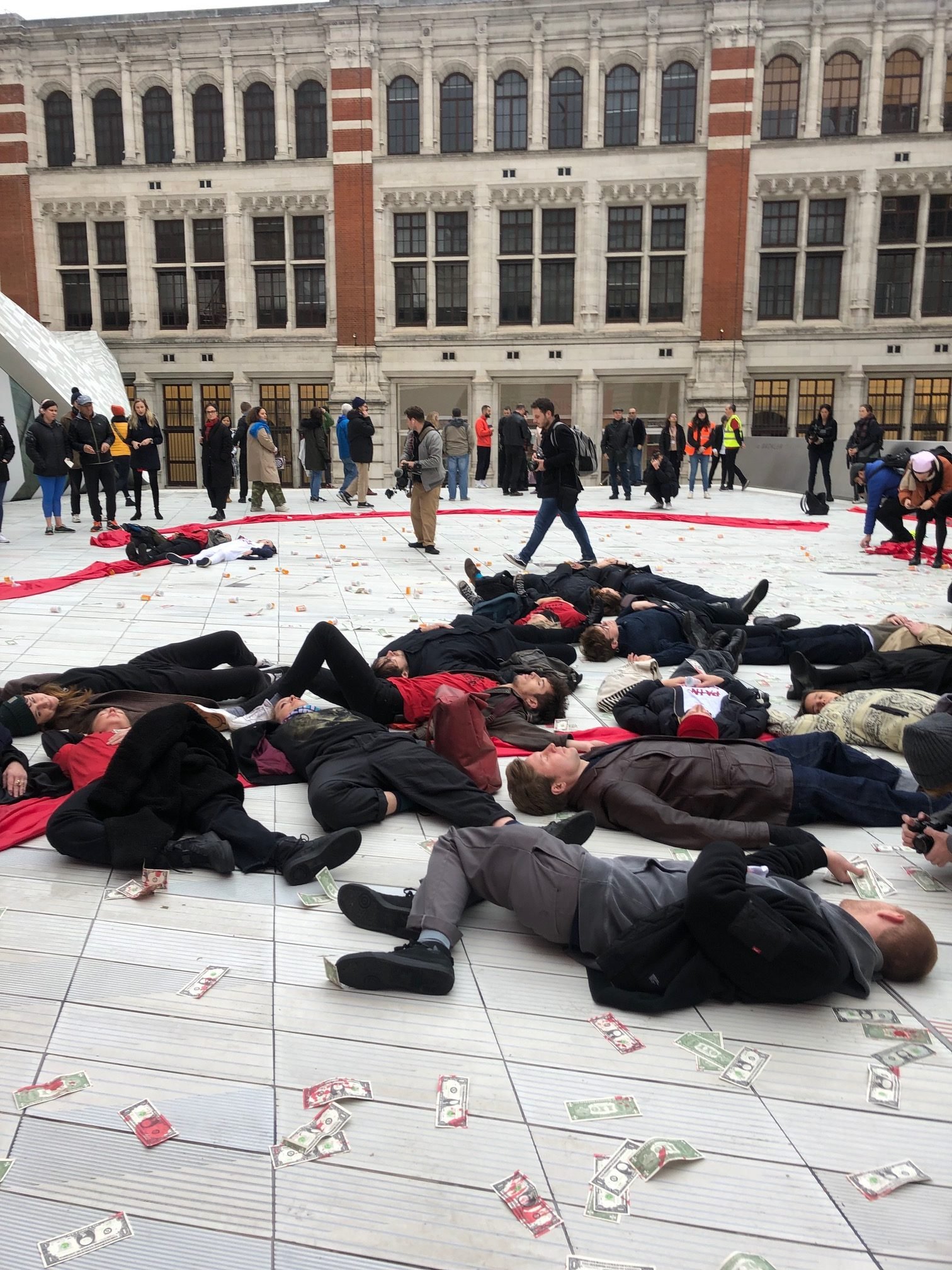
The artist and activist Nan Goldin gathered with members of the Sackler PAIN protest group at the Victoria & Albert Museum in London to stage a demonstration against the institution’s strong ties to the opioid-producing Sackler family.
During their dramatic protest on Saturday, November 16, the group targeted the museum’s director, Tristram Hunt, who said in July that he was “proud” of the Sacklers’ support of the UK’s national museum of art and design. The Sackler name adorns the museum’s new courtyard, which opened to the public in 2017 as part of a major renovation paid for in part by the Dr Mortimer and Theresa Sackler Foundation. (Theresa Sackler is the widow of Mortimer, one of the founders of Purdue Pharma, the company that produced Oxycontin.) UK-based Theresa Sackler has sat on the V&A board since 2011, though her term is due to expire this fall.
The demonstrators, who numbered around two dozen people, chanted: “Five dead each day, shame on V&A,” before staging a die-in in the courtyard. They littered the entrance of the museum with their signature pill bottles and “blood money,” while handing out pamphlets replicating the ones produced by the V&A. PAIN’s leaflets contain information about the scale of the opioid crisis in the UK.
“Tristram Hunt has been so loud and proud about Sackler support, saying that one cannot deny the past,” Megan Kapler, a PAIN spokeswoman, told Artnet News. “We are here to show him that, in fact, no, this is not the past—this is the present,” she added, noting that opioid crisis in the UK is following patterns established in the US.
The Sackler Courtyard was unveiled in 2017 at the Victoria and Albert museum. Photo: Justin Tallis AFP/Getty Images.
The Mortimer and Raymond Sackler branches of the family have been active cultural philanthropists on both sides of the Atlantic for decades. But several members of the dynasty have come under scrutiny for profiting from the sale of Oxycontin, which has been a major driver of the worldwide opioid crisis. This year, Sackler family members were personally named in a US lawsuit accusing them of “shifting hundreds of millions of dollars from the business to themselves” as investigators honed in on the company’s operations, according to the New York Times.
In Europe, there has been a sharp increase in opioid-related deaths, and Scotland and the England are two of the nations that have been most affected. According to a BBC report from earlier this year, drug related deaths in Scotland rose 27 percent between 2017 and 2018.
Yet this summer, Hunt was unequivocal about maintaining the relationship between the V&A and the Sacklers while other cultural institutions were distancing themselves from the family. “We are not going to be taking names down or denying the past,” he said in an interview in July. “We have had strong support from the Sackler family. Theresa Sackler is a trustee of the museum. I think they are reflecting on the controversy. They dispute some elements of it. They have made the decision not to give any more funds.”
Sackler PAIN’s customized Rx bottles and photo-edited “blood money.” Courtesy Sackler PAIN.
“The V&A must stop giving cultural legitimacy and social stature to the family who unleashed this crisis, helping them escape consequences for lives lost,” Nan Goldin said in a statement. “The Sacklers are getting away with murder. Don’t let your legacy be tarnished by their name,” she said.
Since founding Sackler PAIN in 2018, Goldin has led protests across the US, including at the Metropolitan Museum of Art and Guggenheim in New York, and Boston’s Harvard Art Museums, demanding that institutions remove the Sackler name from their walls. The group is also supporting efforts to clawback money they say the Sackler family owes to the public for their role in the spiraling opioid crisis.
Earlier this summer, PAIN made the leap to Europe, staging a dramatic demonstration at the Louvre in Paris during which protestors unraveled a banner saying: “Take Down the Sackler Name.” (Less two weeks later, the museum did just that.) Because of her activism, Goldin was named the most influential artist of the year in Art Review‘s 2019 Power 100 list, a ranking of art-world influencers announced earlier this week.
Goldin’s new exhibition at Marian Goodman gallery in London. “Sirens,” which opened on Friday, November 15, includes a new work called Memory Lost that recounts Goldin’s battles with opioid drug addiction. Goldin began using Oxycontin in 2017 following a minor surgery. The gallery describes the work as one of the “most moving, personal, and visually arresting narratives of Goldin’s career to date.” The show is on view until January 2020.